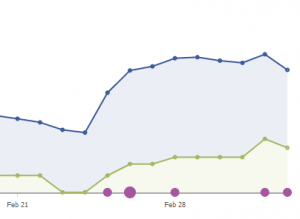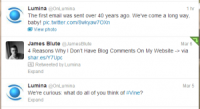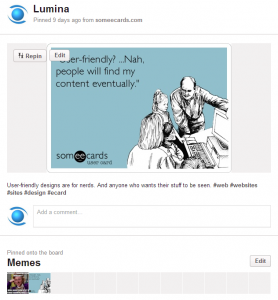A week or so into my new job at Lumina, I realized that I would be wearing a lot of hats. Big and small, colorful and bland, fun and boring; there are a lot of different types, but each one of them is vital. I mean this in a less literal sense of course- although that looks like a lot of fun (I might have to go shopping for hats later…).
Point is, a lot of positions that involve social media, marketing, and web design are actually much more than that. More often than not, if you have a job in this area, you’re expected to have a vast knowledge base and take a lot of different tasks under your belt. Or over your head. 🙂
In regard to social media management, each one of the networks have their own character. Some of them are a little more playful than others. A few of them have certain requirements for how you wear them. And some of them are just plain bigger than others. Right now, we use 4 different social media outlets here at Lumina: Facebook, Google+, Twitter, and Pinterest, with profiles on other sites in the works.
- “What kind of content should I post?”
- “How often should I post it?”
- “What sort of language should I use?”
- “How should I interact with my followers?”
If you’re asking any of these questions, this post should prove useful to you. Here’s a rundown of the common (and best) practices for the 4 social media sites that we use:
 Content: In recent studies, it’s been shown that Facebook users are 50% more likely to view your posts if they involve a visual- an image, images, or video (source: hubspot.com). I’m not saying every post needs to have supporting content, but most of them should.
Content: In recent studies, it’s been shown that Facebook users are 50% more likely to view your posts if they involve a visual- an image, images, or video (source: hubspot.com). I’m not saying every post needs to have supporting content, but most of them should.
Consistency: This really depends on your brand, but I’d suggest posting anywhere from twice a week to twice a day. The bigger your company, the more often you should be posting. But there is definitely such a thing as posting too much. Once you get started, look at your metrics (which Facebook provides), see what works, and tweak your schedule!
Language: A lot of people will tell you on Facebook you either need to talk in business-speak or be really laid back. My opinion? Middle ground. Be conversational, but professional.
Interaction: Social media is about… well, being social. Go figure! So it’s good practice to like any comments you get, and try to respond to any that you can. The more you engage followers, the more likely they are to come back for more.
Google+
 Content: Just like with Facebook, it’s usually good practice to find images, videos, and links to add to posts. It gives ’em character!
Content: Just like with Facebook, it’s usually good practice to find images, videos, and links to add to posts. It gives ’em character!
Consistency: If your company is new to social media (like mine), you should start slow and work your way into a schedule that feels right. Once you gain followers you can start getting an idea of what works.
Language: Let’s face it: Google+ business pages are just that – business pages. Should you only talk in marketing terms and advertise yourself? Though a more professional tone is wise, don’t just spam your followers with CTAs (calls-to-action) and jargon; it IS a social site after all.#
Interaction: It’s all about circles baby! Add people to your circles, let them add you to theirs, so on and so forth. Like Facebook, respond as much as you can.
 Content: 140 characters? That’s rough to stick to, right? Actually, not only is that hard enough, but common practice dictates that you keep it under 110 to leave room for retweets. It’s less important to use images and video on Twitter than the others, but still useful every so often.
Content: 140 characters? That’s rough to stick to, right? Actually, not only is that hard enough, but common practice dictates that you keep it under 110 to leave room for retweets. It’s less important to use images and video on Twitter than the others, but still useful every so often.
Consistency: People sometimes tweet too often. I personally know someone who tweets at least 10 times a day. But if you have enough content to tweet 10 times a day, go for it! But don’t take quantity over quality: if you only have enough content for 2 or so a day, go for 2.
Language: Unlike the rest, it’s encouraged to use web-speak and slang when tweeting. Is it because there’s such a heavy limitation on characters? Probably. But either way, go for broke! …Just not broken sentences, because even if you’re using slang, people need to know what you’re saying.
Interaction: Retweeting can be a huge help in building a rapport with followers. Heck, even with people you don’t know, assuming their tweet is relevant to you and your audience.
 Content: I probably don’t need to tell you that images are where it’s at. But where things get tricky is descriptions for pins. You should never just pin a picture and call it a day. Try to use 2-3 sentences to describe your pin.
Content: I probably don’t need to tell you that images are where it’s at. But where things get tricky is descriptions for pins. You should never just pin a picture and call it a day. Try to use 2-3 sentences to describe your pin.
Consistency: If your company’s very visually-based, then pin a few times a day. If not, maybe once or twice a day will do it. Either way, you should be giving your followers something that they can’t see anywhere other than your boards. Use that. Make them clamor for your pins!
Language: Like Twitter, it’s more acceptable to use slang and web-speak on Pinterest. But unlike Twitter, it’s not semi-necessary. Don’t overdo it. Find a happy medium and wiggle around a bit.
Interaction: Again, very much like Twitter, you should repin things that are interesting and relevant to your company. If you sell cupcakes and see a pin about baked goods, go for the repin. However, if you sell cupcakes and see a pin about puppies, it probably doesn’t have much value to your company (even though we all love puppies).
…Okay, maybe just one puppy pin! 🙂
If you have any comments, questions, or just want to take part in the conversation; please subscribe and comment. I’ll be coming out with helpful articles every week.




Highlу ԁescriρtіve post, I loѵed that bit.
Will theгe be a paгt 2?